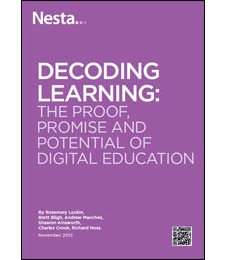 El National Endowment for Science, Technology and the Arts (Nesta) publicó hace unas semanas un informe muy interesante titulado «Decoding learning. The proof, promise and potential of digital education«:
El National Endowment for Science, Technology and the Arts (Nesta) publicó hace unas semanas un informe muy interesante titulado «Decoding learning. The proof, promise and potential of digital education«:
This report sets out where proof, promise and potential lie for technology in education. It then identifies the contextual factors and actions needed to ensure current and future opportunities for school children to take full advantage of technology for learning.
Our starting point is that digital technologies do offer opportunities for innovation that can transform teaching and learning, and that our challenge is to identify the shape that these innovations take. To aid us in this task, we have rejected the lure of categorising innovations by the type of technology employed. The only answer to questions such as “do games help learning?” is to say, “it depends.” Instead we argue that more progress comes from thinking about the types of learning activities that we know to be effective, such as practising key skills, and exploring the ways that technology can support and develop these effective learning activities in innovative ways.
Es una lectura interesante porque uno tiende a pensar que Spain is different y que las cosas que pasan aquí no pasan en ninguna parte. Pero nos equivocamos.
¿Y qué recomendaciones ofrecen los autores? Aquí van unos párrafos seleccionados del capítulo de conclusiones:
We looked for proof, potential and promise in digital education.
We found proof by putting learning first. We have shown how different technologies can improve learning by augmenting and connecting proven learning activities. This approach gives us a new framework for evaluating future innovations in education.
The numerous examples of good practice identified in this report show that there is also
a great deal that can be done with existing technology. It is clear that there is no single technology that is ‘best’ for learning. We have identified technology being used effectively to support a variety of learning activities and learners across a wide range of subjects and learning environments. rather, different technologies can be used to support different forms of learning, either individually or in conjunction with others.There is a growing body of invaluable evidence that demonstrates how technology can
be used effectively to support learning. however, if that evidence is going to be useful in practice it needs to address the contexts within which the technology is used; and it needs to be presented in ways that are accessible to industry, teachers and learners.We found clear potential to make better use of technologies that are widely available and that many schools have already purchased. but this potential will only be realised through innovative teaching practice. Teachers may require additional training that enables them to use technologies in new ways.
There is enormous potential for further innovation in digital education. Success will come from commercial developers, researchers, teachers and learners working together to develop, test and spread imaginative new technologies.
We also found many areas of promise; that is, areas where technology is currently undervalued and underused. We found relatively little technological innovation in some of the more effective learning themes we considered in chapter 2. for example, the market is saturated with drill and practice games (particularly for maths) to support Learning through Practising despite being regarded as one of the less powerful learning themes. meanwhile, there has been relatively little technological innovation aimed at supporting Learning through Assessment – which can be a powerful aid to teaching and learning.
Over recent decades, many efforts to realise the potential of digital technology in education have made two key errors. collectively, they have put the technology above teaching and excitement above evidence. This means they have spent more time, effort and money looking to find the digital silver bullet that will transform learning than they have into evolving teaching practice to make the most of technology. If we are to make progress we need to clarify the nature of the goal we want to satisfy through future innovation. much existing teaching practice may well not benefit greatly from new technologies. as we continue to develop our understanding of technology’s proof, potential and promise, we have an unprecedented opportunity to improve learning experiences in the classroom and beyond.
Los docentes del Reino Unido y los españoles cuando usan las TIC… pues no son tan diferentes.
Y, sorpresa, la prensa también es bastante parecida. Un par de muestras del «arte» de escribir titulares relacionadas con el informe:
- BBC – Costly hi-tech kit lies unused in schools, says study
- Telegraph – Schools ‘wasting £450m a year’ on useless gadgets.
En todas partes cuecen habas.
Me hierve la sangre cuando leo algún artículo criticando la infrautilización de tecnologías de la información en la docencia. Soy profesor de secundaria en Galicia: Un aula de informática con 16 ordenadores para compartir entre 500 alumnos. Y encima tenemos que leer gilipolleces….